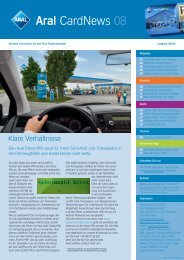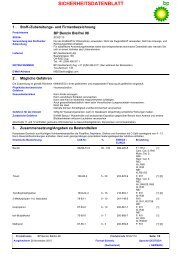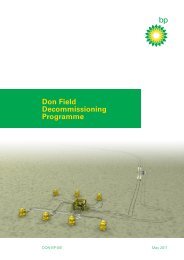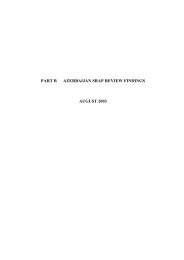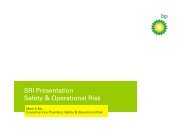BP in Angola Sustainability Report 2010 (pdf, 3860KB)
BP in Angola Sustainability Report 2010 (pdf, 3860KB)
BP in Angola Sustainability Report 2010 (pdf, 3860KB)
You also want an ePaper? Increase the reach of your titles
YUMPU automatically turns print PDFs into web optimized ePapers that Google loves.
workforce has travelled, on average,<br />
approximately 2.8 million km per year over the<br />
past five years. Our total vehicle accident rate,<br />
which measures vehicle accidents per one<br />
million kilometres driven, has fallen<br />
significantly s<strong>in</strong>ce 2008. However, one<br />
third-party pedestrian was fatally <strong>in</strong>jured <strong>in</strong> an<br />
accident <strong>in</strong>volv<strong>in</strong>g a <strong>BP</strong>-owned vehicle <strong>in</strong><br />
<strong>2010</strong>. Our drivers carry out defensive driv<strong>in</strong>g<br />
tra<strong>in</strong><strong>in</strong>g every two years and we use an<br />
automated driv<strong>in</strong>g <strong>in</strong>formation system to<br />
monitor our drivers’ behaviour.<br />
Progress<strong>in</strong>g towards OMS<br />
In common with other assets across the<br />
group, <strong>BP</strong> <strong>Angola</strong> is <strong>in</strong>troduc<strong>in</strong>g an operat<strong>in</strong>g<br />
management system (OMS), a framework to<br />
drive a rigorous and systematic approach to<br />
safety, risk management and operational<br />
<strong>in</strong>tegrity across the company.<br />
The OMS <strong>in</strong>tegrates requirements<br />
regard<strong>in</strong>g health, personal and process safety,<br />
security, environmental and operational<br />
reliability, as well as related issues such as<br />
ma<strong>in</strong>tenance, contractor relations and<br />
organizational learn<strong>in</strong>g, <strong>in</strong>to a common<br />
system. <strong>BP</strong> firmly believes that the OMS<br />
provides the right foundations to achieve<br />
operational excellence.<br />
Follow<strong>in</strong>g a safety and operations audit <strong>in</strong><br />
2009 on Greater Plutonio and an <strong>in</strong>itial OMS<br />
gap assessment held <strong>in</strong> 2009-10, our progress<br />
<strong>in</strong> implement<strong>in</strong>g OMS was <strong>in</strong>terrupted by the<br />
temporary transfer of key staff to help with the<br />
response effort <strong>in</strong> the Gulf of Mexico. To move<br />
forward, we plan to refresh the gap<br />
assessment and progress with implementation<br />
<strong>in</strong> the structured and calculated manner which<br />
the events of <strong>2010</strong> made impossible. The gap<br />
assessment will deliver a new project plan and<br />
schedule for implementation, beg<strong>in</strong>n<strong>in</strong>g <strong>in</strong><br />
2012. Implementation will be phased and will<br />
be risk-based. The system will be audited<br />
by <strong>BP</strong> group S&OR auditors towards the end<br />
of 2012, <strong>in</strong> l<strong>in</strong>e with the three year cycle of<br />
scheduled audits.<br />
Contractor oversight<br />
We have long recognised the importance of<br />
build<strong>in</strong>g safety capability and rais<strong>in</strong>g safety<br />
awareness among our contractors and<br />
suppliers. Many of our operations, <strong>in</strong>clud<strong>in</strong>g<br />
deepwater drill<strong>in</strong>g, rely on the expertise of<br />
contractors. Across <strong>BP</strong>, we are review<strong>in</strong>g how<br />
we work with contractors and other <strong>in</strong>dustry<br />
partners, onshore and offshore, to <strong>in</strong>form future<br />
relationships and address the oversight and<br />
management of safety and operational risk.<br />
In <strong>Angola</strong>, we have held workshops with<br />
our contractors that br<strong>in</strong>g together<br />
management from the contract<strong>in</strong>g companies<br />
to share best practice on health, safety and<br />
environment and discuss lessons learned from<br />
<strong>in</strong>cidents.<br />
Protect<strong>in</strong>g health<br />
Ma<strong>in</strong>ta<strong>in</strong><strong>in</strong>g the health of employees is an<br />
important consideration <strong>in</strong> deliver<strong>in</strong>g safe<br />
operations. As part of our annual plan for<br />
promot<strong>in</strong>g health, we have implemented<br />
policies and procedures cover<strong>in</strong>g the ma<strong>in</strong><br />
health risks for our employees such as fitness<br />
for task, malaria, HIV/AIDS and substance<br />
misuse.<br />
Although UNDP statistics <strong>in</strong>dicate that<br />
the mortality rate from malaria <strong>in</strong> <strong>Angola</strong><br />
decreased from 2005-09, the disease rema<strong>in</strong>s<br />
the biggest natural threat to life <strong>in</strong> Africa, with<br />
the most dangerous form of the disease<br />
present <strong>in</strong> the country. Our malaria<br />
management plan describes how <strong>BP</strong> <strong>Angola</strong><br />
seeks to reduce the health risks to our<br />
employees, their dependants, contractors and<br />
bus<strong>in</strong>ess visitors from exposure to malaria<br />
while work<strong>in</strong>g, liv<strong>in</strong>g or visit<strong>in</strong>g <strong>Angola</strong>. Its<br />
measures <strong>in</strong>clude manag<strong>in</strong>g exposure to<br />
malaria risk through education, bite prevention,<br />
and the provision of anti-malarial drugs.<br />
An important part of our effort <strong>in</strong>volves<br />
build<strong>in</strong>g the capacity of local staff <strong>in</strong><br />
occupational health and <strong>in</strong>dustrial hygiene. To<br />
do this, we are follow<strong>in</strong>g an <strong>in</strong>ternational<br />
modular framework for the tra<strong>in</strong><strong>in</strong>g and<br />
capability development of <strong>in</strong>dustrial hygienists<br />
<strong>in</strong> <strong>BP</strong> <strong>Angola</strong>. Students can choose to take<br />
courses <strong>in</strong> fields such as the measurement<br />
and control of hazardous substances, and<br />
noise assessment and control, aim<strong>in</strong>g for<br />
stand-alone qualifications <strong>in</strong> areas of specific<br />
<strong>in</strong>terest and relevance.<br />
<strong>BP</strong> <strong>Angola</strong> is <strong>in</strong>troduc<strong>in</strong>g an<br />
operat<strong>in</strong>g management system<br />
to drive a rigorous and systematic<br />
approach to safety, risk<br />
management and operational<br />
<strong>in</strong>tegrity.<br />
Safety<br />
Paulo Pizarro, <strong>BP</strong> <strong>Angola</strong> Vice President,<br />
Communications and External Affairs and Inocencio<br />
de Brito, <strong>Angola</strong> Director of Traffic Police<br />
Improv<strong>in</strong>g road safety<br />
In December <strong>2010</strong>, <strong>BP</strong> <strong>Angola</strong>, the National<br />
Department of Road Traffic Police (DNVT),<br />
and Sete Cam<strong>in</strong>hos (a local market<strong>in</strong>g agency),<br />
signed a Memorandum of Understand<strong>in</strong>g<br />
(MoU) to implement a road safety campaign <strong>in</strong><br />
<strong>Angola</strong>.<br />
<strong>BP</strong> <strong>Angola</strong> decided to support a road<br />
safety programme <strong>in</strong> the light of the current<br />
figures for road accidents <strong>in</strong> <strong>Angola</strong>. Road<br />
traffic accidents represent the second most<br />
significant cause of death after malaria <strong>in</strong> the<br />
country. The campaign was focused on the<br />
festive season, when the frequency of road<br />
traffic accidents tends to <strong>in</strong>crease.<br />
The aim of the campaign was to reduce<br />
the number of fatalities, <strong>in</strong>juries and property<br />
damage result<strong>in</strong>g from road accidents <strong>in</strong><br />
<strong>Angola</strong>, by rais<strong>in</strong>g awareness of road safety<br />
through television and radio spots aired dur<strong>in</strong>g<br />
the festive season, as well as outdoor<br />
advertis<strong>in</strong>g strategically placed <strong>in</strong> areas with<br />
more accidents.<br />
<strong>BP</strong> <strong>Angola</strong> Vice President for<br />
Communications and External Affairs, Paulo<br />
Pizarro, said: “It is an honour to participate <strong>in</strong> this<br />
<strong>in</strong>itiative as it will help save lives and make our<br />
roads safer. We believe that most of the road<br />
accidents, if not all of them, are preventable. We<br />
tra<strong>in</strong> our drivers and ma<strong>in</strong>ta<strong>in</strong> our cars, which<br />
helps us to manage the road safety risks for our<br />
employees and their families. By support<strong>in</strong>g<br />
DNVT with a wider road safety campaign as well<br />
as other road safety <strong>in</strong>itiatives, we hope to<br />
contribute significantly to reduc<strong>in</strong>g the number<br />
of road accidents <strong>in</strong> <strong>Angola</strong>.”<br />
While it is difficult to attribute outcomes<br />
directly to an <strong>in</strong>itiative of this type, we were<br />
pleased to see that the number of fatal road<br />
traffic accidents dur<strong>in</strong>g the Christmas and<br />
New Year period <strong>in</strong> <strong>2010</strong> was 30% lower than<br />
the correspond<strong>in</strong>g period <strong>in</strong> 2009. The total<br />
number of accidents was 25% lower.<br />
<strong>BP</strong> <strong>in</strong> <strong>Angola</strong> Susta<strong>in</strong>ability <strong>Report</strong> <strong>2010</strong> 19




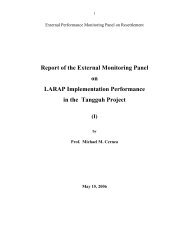
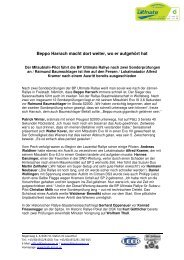
![[PDF] Deepwater Horizon: Accident Investigation Report - BP](https://img.yumpu.com/51697031/1/190x245/pdf-deepwater-horizon-accident-investigation-report-bp.jpg?quality=85)

